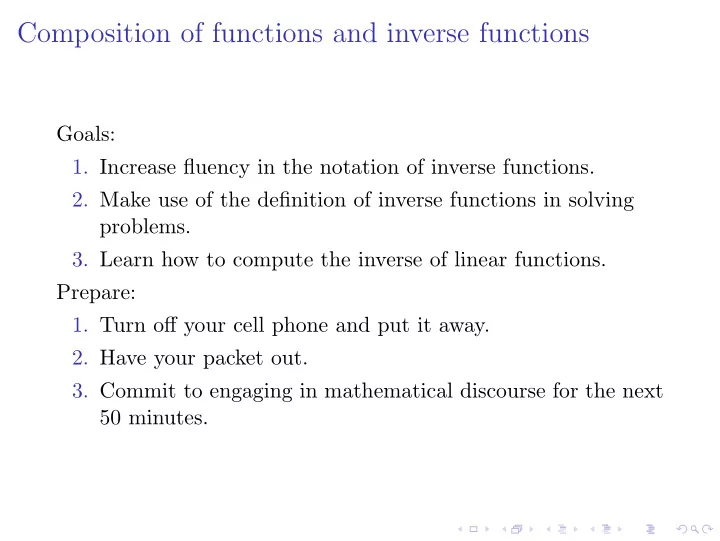

Composition of functions and inverse functions Goals: 1. Increase fluency in the notation of inverse functions. 2. Make use of the definition of inverse functions in solving problems. 3. Learn how to compute the inverse of linear functions. Prepare: 1. Turn off your cell phone and put it away. 2. Have your packet out. 3. Commit to engaging in mathematical discourse for the next 50 minutes.
Question How do you eat an elepehant?
Composition of functions. Can you represent the function h ( x ) = (2 − 3 x ) 2 as a composition of two functions? Click in: 1. yes. 2. no
Composition of functions. Can you represent the function h ( x ) = x as a composition of two functions? Click in: 1. yes. 2. no
Inverse function. Definition Let f : R → R be a function. If there is another function g : R → R such that f ◦ g ( x ) = g ◦ f ( x ) = x, then g is the inverse of f and we write g = f − 1 .
Inverse functions. We saw yesterday that not every function has an inverse (ex: f : R → R , f ( x ) = x 2 ). Question Does the function f : R → R given by the rule f ( x ) = x 3 have an inverse? Think about making graph to help you investigate the question. Click in: 1. yes. 2. no.
Inverse functions. Question Let f : R → R and g : R → R be two functions. Assume that f is an invertible function and f − 1 ( x ) = 3 x 3 . If we know that f ◦ g ( x ) = 3 x + 4 what is g ( x ) ?
Inverse functions. Question (3.33) Suppose that f and g both have an inverse. Show that if h = f ◦ g , then the inverse of h is g − 1 ◦ f − 1 .
Inverse functions. Question Suppose that f and g both have an inverse. What is the inverse of g ◦ f ?
Inverse functions. Question f : R → R is a function given by the following algebraic rule: f ( x ) = 4 x + 5 1. What is f (4)? 2. What is f − 1 (21)? 3. What is f − 1 (12)? 4. What is f − 1 (7)? 5. What is f − 1 (100)? 6. What is f − 1 ( b )? 7. What is f − 1 ( x )?
Recommend
More recommend